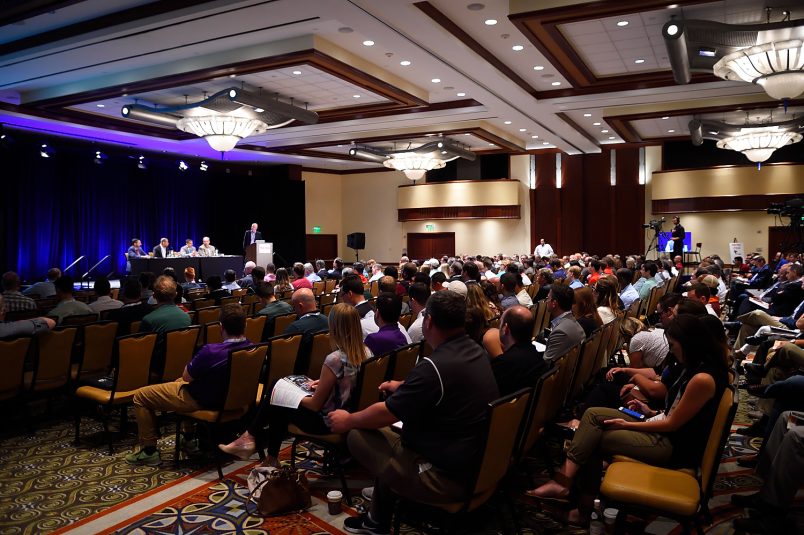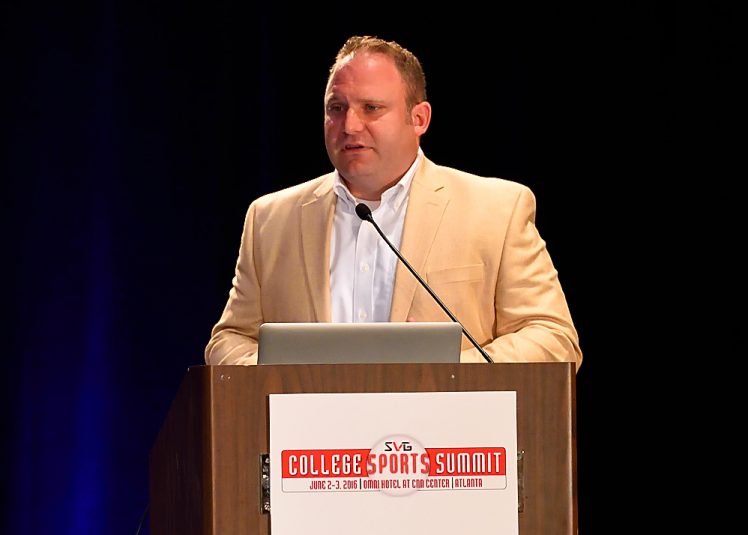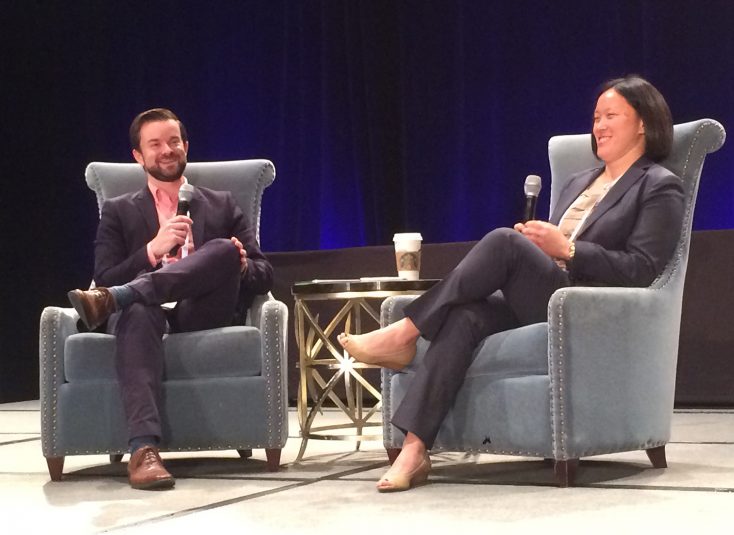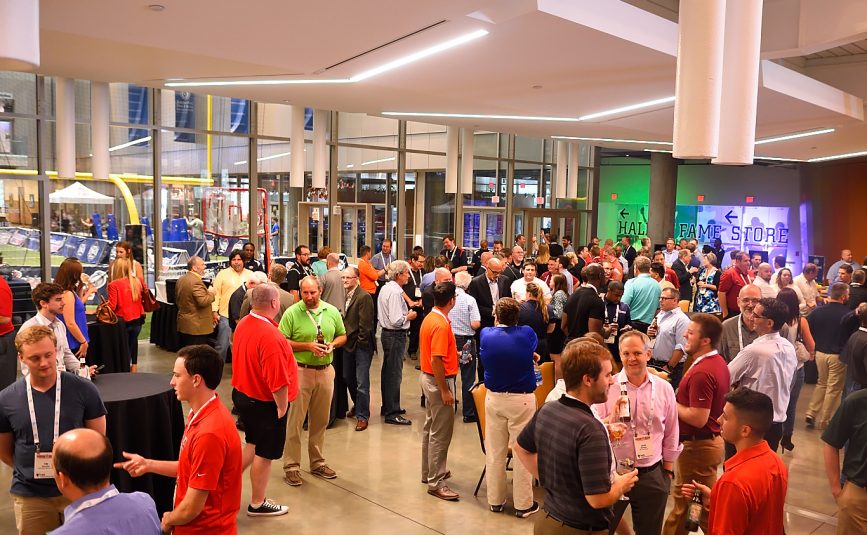SVG College Sports Summit Draws Record Crowd, Unites Blossoming Industry
Story Highlights
The eighth-annual SVG College Sports Summit was bigger than ever in Atlanta this week. More than 500 industry professionals from athletic departments, conference offices, academic programs, production companies, national and regional networks, and leading technology vendors gathered to network and share best practices in college-sports-video production.
The program featured a full day of sessions that kicked off with opening remarks by 2016 Advisory Board Chairman Imry Halevi, director, multimedia and production, Harvard University.
“Every year, there is always a moment at this conference where people look up and a light bulb turns on because someone on stage says something that’s meaningful to you — either a solution for a problem or a solution you have experienced as well,” he told attendees. “That is unique. I go to a lot of conferences throughout the year, and that doesn’t always happen. But it happens here every year — and even every session. That is what this conference is all about.”
On Day 1, keynote speaker Robert Shaw, Global Sports Media Partnerships, Facebook, imparted his keys to success in a digital-first content world and discussed how to get the most out of Facebook content strategy. Most notably, he examined the emergence of Facebook Live and how the live-streaming tool can help schools create interactive, intimate, and immediate content to better engage fans.
“The numbers have been amazing,” he said. “Within a few months, we are already seeing tens of millions of people going live every single day. So it’s happening today, it’s immediate, and it’s around the world.
Shaw noted two major opportunities in sports for Facebook Live: creating original ancillary content around the game itself and distributing alternative or lower-tier sports events that would not otherwise be carried live.
In terms of ancillary content, he highlighted such examples as using Facebook Live to live-stream NBA MVP Steph Curry’s three-point shooting routine during pregame warm-ups, Cowboys QB Tony Romo’s analysis and fan Q&A during Super Bowl 50, a POV shot of Jarvis Landry as he ran onto the field during the NFL Pro Bowl, Denver Broncos QB Peyton Manning’s retirement press conference, and Bleacher Report’s NFL Draft studio show, as well as ESPN’s incorporating Facebook Live messages into its linear SportsCenter telecast.
In terms of event distribution, he noted Alex Morgan’s live stream of her team’s game, which would not have been broadcast otherwise. He also noted that colleges, especially, can take advantage of Facebook Live as a distribution platform for non-revenue sports that may not garner a large audience or be presented at all.
“There is a lot of content that you may not have thought about for a live broadcast,” Shaw added. “There are actually plenty of pieces of content. Whether it’s Steph Curry doing a three-point barrage during pregame [warm-ups] or players running onto the field, those are big, meaningful moments that people want to see. It’s not necessarily something they want on the big screen; it’s something they want to take out of their pocket and watch intimately.”
In addition to an in-depth look at Facebook Live, Shaw provided an overview of the latest developments from the social-media giant: new platforms like Instant Articles, Oculus Rift VR and 360 video, Facebook/Instagram VOD, and Sports Stadium. He also noted new tools for sports-media organizations: branded content, rights management, a video tab, and leveraging Facebook’s API.
In addition to an opening panel featuring top producers and directors telling tales from the front bench, industry leaders discussed how to build and maintain a conference digital network, storage/archiving and asset-management challenges, venue videoboard production and in-stadium fan engagement, and how to create short-form video content for a changing social-media landscape. The Summit’s opening day also featured a pair of technology case studies from Elemental Technologies and JVC, as well as Storytellers Stage presentations by Big Ten Network (on its production of The Journey docuseries) and Pac-12 Networks (Oregon Men’s Basketball piece).
The Day 2 program was headlined by America East Conference Commissioner Amy Huchthausen (recently named one of Sports Business Journal’s 40 Under 40), whose keynote speech focused on how video is core to America East’s strategy and how a mid-major conference can shine in the crowded digital-media landscape.
Huchthausen acknowledged that in a crowded sports market in the northeast U.S., America East faces an uphill battle in getting its video content and brand out to the masses. As a result, the conference has focused on building out its digital network and social media presence with content that appeals directly to America East fans.
Friday morning’s sessions also included a Case Study highlighting Clemson’s Social Video workflow at the CFP National Championship Game and a technology case study by EVS centered on The Live Connected Campus. And the schedule featured two specialized workshop tracks: The Content Evolution: New World Strategies In Video Creation and Roll Up Your Sleeves: Critical Conversations in Production.
In addition to the informational sessions and case studies, attendees were treated to networking opportunities with their peers and the chance to check out the latest from more than 40 of the world’s top video-technology developers. Among them was the event’s Title Sponsor, Ross Video.
“When you look at the last five years, the [college-video industry] has really upped their game, and Ross Video is happy to be a part of it,” said Ross Video CEO David Ross during opening comments. “Another great thing is, so many of your students are currently using products like our Carbonite switchers and Xpression graphics. So, once they graduate, there is already this huge group of people who will be able to enter the Open Truck Ross mobile environment and get jobs right away and know what they’re doing. That’s a win-win for everybody.”
The SVG College Sports Summit has grown into the annual destination for professionals in college sports video. Attendees were welcomed at the Opening Night Reception at the College Football Hall of Fame, were honored for their work at the SVG/NACDA College Sports Media Awards, and had the opportunity to see the technology behind the scenes at CNN Studios.




